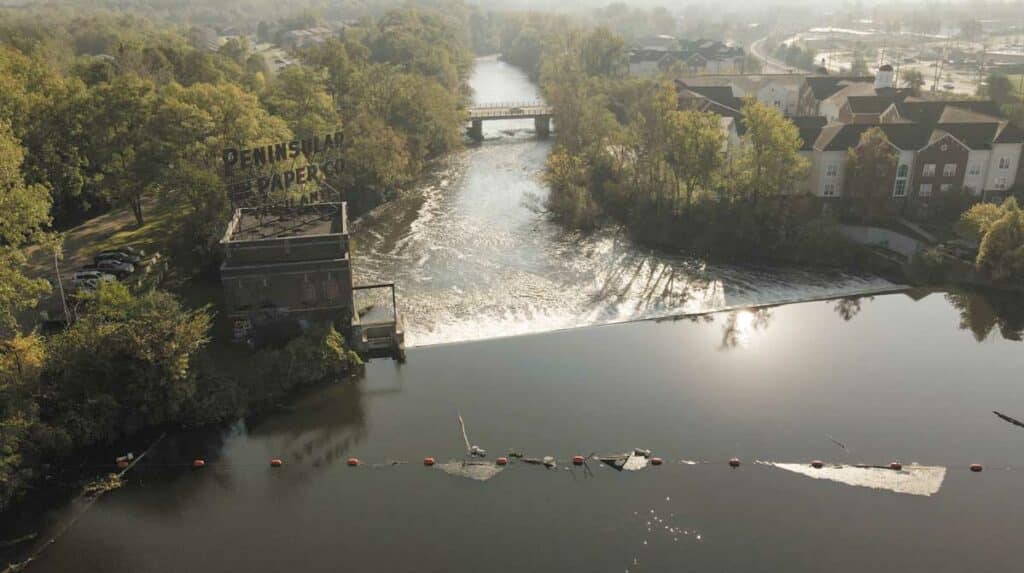
EGLE funding supports next phase for HRWC and Ypsilanti
The City of Ypsilanti, with support from HRWC, received a $3.78 million grant from the Department of Environment, Great Lakes, and Energy (EGLE) Dam Risk Reduction program to remove Peninsular Paper Dam. Pen Dam is a high-hazard dam recently downgraded to “poor” condition. The high hazard rating indicates severe damage and loss of life is likely if the dam were to fail.
The dam once provided electrical and mechanical energy for the nearby Peninsular Paper Mill. However, the hydropower equipment and connecting infrastructure was long gone before the city bought the dam and land around it for one dollar in 1986. In recent years, the city has struggled to insure the dam against the potential of failure. In 1995, the Michigan Department of Natural Resources (MDNR) identified Pen Dam as one of three dams on the Huron River’s main stem that would be most beneficial to fish and wildlife to remove. The other two are the Mill Pond Dam in Dexter (since removed) and Argo Dam in Ann Arbor.
The EGLE grant award is a major milestone in the project. It demonstrates a significant commitment from the state to address a hazardous piece of obsolete infrastructure. MDNR and the U.S. Fish and Wildlife Service, along with other local, state, and federal agencies, have also been supportive throughout the project. MDNR previously provided $650,000 in grant support over two cycles of their Fisheries Habitat Grant Program. That funding advanced the removal planning to the point it is today.
There is still a lot to do, however, before the actual dam deconstruction can go forward. The EGLE grant provides partial funding – but more funding must be secured before water levels in the impoundment can be drawn down and the dam structure removed. With that in mind, HRWC and Ypsilanti are also pursuing numerous other funding opportunities to restore the river above Ford Lake and below Superior Dam. The goal is to raise funds beyond the bare minimum amount of work to remove the dam; the partners will also raise funds to restore the impoundment area to a safe, resilient, and ecologically beneficial river corridor. Project partners feel that a more comprehensive restoration plan will be well worth the need for extra funds and will provide an added value to the local community.
Current Status
The removal design is nearing its final phase. The project team now has a better understanding of the steps that will be necessary to safely and slowly deconstruct the dam, restore the river, and protect areas downriver during construction. The City of Ypsilanti is providing updates on the project on the City’s website as they become available.
Consulting engineers from LimnoTech, Inter-fluve, and AECOM have studied the underwater shape of the impoundment, approximated the alignment of the natural river’s original channel, and estimated the amount of sediment that needs to be moved to reconstruct the waterway. The specific details will change somewhat along with the final design, but there is good news: the amount of sediment found in the impoundment was lower than expected, and the toxicity of the material that has built up behind the dam is relatively low for a dam on a river in an industrial area. That said, some excavation of sediment will be required. In a few places the sediment will be removed from the site entirely. In most locations, the sediment can be used in the restoration of the river corridor.
What’s Next
One of the next tasks is a survey for threatened or endangered mussels. The Huron River has good habitat for these vital, unassuming organisms, and this stretch could be especially beneficial once restored. Teams will be trained to locate and identify different species, and if any sensitive varieties are found, they will be relocated before dam removal begins.
Removal of the actual dam will be a slow, methodical process, first by removing stoplogs at one end of the dam, then by chipping away at the top of the concrete structure to drain the impoundment. The sediment allowed to pass will be managed to avoid unhealthy effects on fish and wildlife. As the water level falls, restoration of exposed lands will begin. Invasive species will be removed, banks stabilized, bridges fortified, and native seeds planted. In the best-case scenario, the bulk of the construction work could take place in 2025 and is expected to last about a year.
Other dam removals across the state, including the Mill Pond Dam in Dexter, have shown us that the impoundment will revegetate quickly, greening up in the first two years after dam removal. Grasses and shrubs will come first, followed by larger trees. After five to ten years, it will be difficult to tell whether there was ever a dam there.
Major river restoration projects like this one are ‘once in a generation opportunities’ to make our communities safer, healthier, and more resilient for people and wildlife. HRWC is looking forward to working with Ypsilanti and other partners to restore this stretch of Huron River to its original splendor.
—Daniel A. Brown
Learn more about Ypsilanti Pen Dam Check out a guest blog: Removing Ypsilanti’s Peninsular Paper Dam Prepares for the FutureThis blog post is also published in the Huron River Report, Fall 2023.



